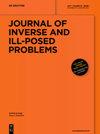具有Kelvin-Voigt阻尼的Euler-Bernoulli梁中未知横向剪力的反演问题
IF 1
4区 数学
Q2 MATHEMATICS
引用次数: 2
摘要
摘要本文研究了由阻尼Euler–Bernoulli方程ρ,ℓ ) ×(0,T],\rho(x)u_{tt}+\mu(x)u_{T}+(r(x)u-{xx})_{xx}+ℓ = 0,-[(r(x)u x x+κ(x)ux x t)x]x=ℓ = g(t),u(0,t)=0,\quad u_{x}ℓ , t){\nu(t):=u(\ell,t)},t∈[0,t]{t\in[0],t]},并且从弯矩ω,其中项(κ(x)u x t)x{(\kappa(x)u_{xxt})_{xx}}和μ(x)ut{\mu(x)u_{t}}分别说明了Kelvin-Voigt阻尼和外部阻尼。本研究的主要目的是通过给定的边界测量,分析Kelvin–Voigt阻尼对确定未知横向剪切力(边界输入)的影响。将Tikhonov泛函的逆问题转化为极小化问题,并证明正则化泛函允许逆问题的唯一解。通过剪切力容许类g(t){g(t)}上的适当正则性,我们证明了这些泛函是Fréchet可微的,并且导数是通过将测量数据作为与直接问题相关的边界数据提出的相应伴随问题的解来表示的。这些伴随问题的可解性是在边界数据g(t){g(t)}的最小正则性下获得的,这是直接问题中Kelvin–Voigt阻尼的正则化效应。此外,使用更正则化的Tikhonov泛函的Fréchet导数,我们仅在Kelvin–Voigt阻尼系数的可行条件下,就给定测量值而言,获得了横向剪切力的显著Lipschitz稳定性估计。本文章由计算机程序翻译,如有差异,请以英文原文为准。
Inverse problems of identifying the unknown transverse shear force in the Euler–Bernoulli beam with Kelvin–Voigt damping
Abstract In this paper, we study the inverse problems of determining the unknown transverse shear force g ( t ) {g(t)} in a system governed by the damped Euler–Bernoulli equation ρ ( x ) u t t + μ ( x ) u t + ( r ( x ) u x x ) x x + ( κ ( x ) u x x t ) x x = 0 , ( x , t ) ∈ ( 0 , ℓ ) × ( 0 , T ] , \rho(x)u_{tt}+\mu(x)u_{t}+(r(x)u_{xx})_{xx}+(\kappa(x)u_{xxt})_{xx}=0,\quad(x,% t)\in(0,\ell)\times(0,T], subject to the boundary conditions u ( 0 , t ) = 0 , u x ( 0 , t ) = 0 , [ r ( x ) u x x + κ ( x ) u x x t ] x = ℓ = 0 , - [ ( r ( x ) u x x + κ ( x ) u x x t ) x ] x = ℓ = g ( t ) , u(0,t)=0,\quad u_{x}(0,t)=0,\quad[r(x)u_{xx}+\kappa(x)u_{xxt}]_{x=\ell}=0,% \quad-[(r(x)u_{xx}+\kappa(x)u_{xxt})_{x}]_{x=\ell}=g(t), for t ∈ [ 0 , T ] {t\in[0,T]} , from the measured deflection ν ( t ) := u ( ℓ , t ) {\nu(t):=u(\ell,t)} , t ∈ [ 0 , T ] {t\in[0,T]} , and from the bending moment ω ( t ) := - ( r ( 0 ) u x x ( 0 , t ) + κ ( 0 ) u x x t ( 0 , t ) ) , t ∈ [ 0 , T ] , \omega(t):=-(r(0)u_{xx}(0,t)+\kappa(0)u_{xxt}(0,t)),\quad t\in[0,T], where the terms ( κ ( x ) u x x t ) x x {(\kappa(x)u_{xxt})_{xx}} and μ ( x ) u t {\mu(x)u_{t}} account for the Kelvin–Voigt damping and external damping, respectively. The main purpose of this study is to analyze the Kelvin–Voigt damping effect on determining the unknown transverse shear force (boundary input) through the given boundary measurements. The inverse problems are transformed into minimization problems for Tikhonov functionals, and it is shown that the regularized functionals admit unique solutions for the inverse problems. By suitable regularity on the admissible class of shear force g ( t ) {g(t)} , we prove that these functionals are Fréchet differentiable, and the derivatives are expressed through the solutions of corresponding adjoint problems posed with measured data as boundary data associated with the direct problem. The solvability of these adjoint problems is obtained under the minimal regularity of the boundary data g ( t ) {g(t)} , which turns out to be the regularizing effect of the Kelvin–Voigt damping in the direct problem. Furthermore, using the Fréchet derivative of the more regularized Tikhonov functionals, we obtain remarkable Lipschitz stability estimates for the transverse shear force in terms of the given measurement by a feasible condition only on the Kelvin–Voigt damping coefficient.
求助全文
通过发布文献求助,成功后即可免费获取论文全文。
去求助
来源期刊

Journal of Inverse and Ill-Posed Problems
MATHEMATICS, APPLIED-MATHEMATICS
CiteScore
2.60
自引率
9.10%
发文量
48
审稿时长
>12 weeks
期刊介绍:
This journal aims to present original articles on the theory, numerics and applications of inverse and ill-posed problems. These inverse and ill-posed problems arise in mathematical physics and mathematical analysis, geophysics, acoustics, electrodynamics, tomography, medicine, ecology, financial mathematics etc. Articles on the construction and justification of new numerical algorithms of inverse problem solutions are also published.
Issues of the Journal of Inverse and Ill-Posed Problems contain high quality papers which have an innovative approach and topical interest.
The following topics are covered:
Inverse problems
existence and uniqueness theorems
stability estimates
optimization and identification problems
numerical methods
Ill-posed problems
regularization theory
operator equations
integral geometry
Applications
inverse problems in geophysics, electrodynamics and acoustics
inverse problems in ecology
inverse and ill-posed problems in medicine
mathematical problems of tomography
 求助内容:
求助内容: 应助结果提醒方式:
应助结果提醒方式:


